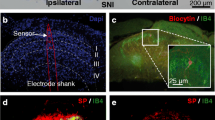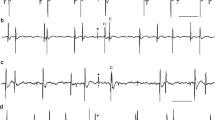Abstract
Stimulus-dependent inhibition of discharges from cutaneous C fibers from mechanothermosensitive (MTS) units (nociceptive sensors) can explain the paradoxical analgesic effect of local anesthetics at low concentrations, insufficient to block axonal conduction of nerve impulses. Three types of experiments are proposed which could detect the stimulus-dependent inhibition of the terminal section of sensory C units: a method involving repeated series of stimuli, the increasing stimulus method, and the spike encounter method. The applications of these methods to assessing the magnitudes of the neuroleptic effects of local anesthetics and cardiac antiarrhythmics is discussed.
Similar content being viewed by others
References
L. V. Borovikova, D. V. Borovikov, V. V. Ermishkin, and S. V. Revenko, “Tonic and stimulus-dependent inhibition by lidocaine and N-propylajmaline of the responses of polymodal C-units in cat skin to thermal stimuli.”Sensor. Sistemy,11, No. 2, 107–117 (1997).
N. E. Vvedenskii, “Excitation, inhibition, anesthesia,” in:Physiology of the Nervous System [in Russian], GIML, Moscow (1952), Vol. 2.
S. V. Revenko, V. V. Ermishkin, and L. Ya. Selektor, “Excitation of group C mechanosensitive sensory units in the cat skin in conditions of intra-arterial administration of potassium ions,”Neirofiziologiya,20, No. 2, 147–154 (1988).
S. V. Revenko, L. V. Baidakova, V. V. Ermishkin, N. A. Mangusheva, and L. Ya. Selektor, “Studies of pain reception in the skin using chemical agents,”Neirofiziologiya,24, No. 5, 517–529 (1992).
S. V. Revenko, L. V. Borovikova, D. V. Borovikov, and V. V. Ermishkin, “Resistance of the terminal part of polymodal C-units of cat skin to tetrodotoxin during excitation with mechanical and thermal stimuli,”Byull. Éksp. Biol. Med. 124, No. 10, 369–371 (1997).
B. I. Khodorov, “Two mechanisms of ‘stimulus-dependent’ action of pharmacological agents on the electrical and contractile activities of myocardial cells,”Kardiologiya,20, No. 5, 7–10 (1980).
S. E. Abram and T. L. Yaksh, “Systemic lidocaine blocks nerve injury-induced hyperalgesia and nociceptor-driven spinal sensitization in the rat,”Anesthesiology,80, 383–391 (1994).
L. V. Borovikova, D. V. Borovikov, V. V. Ermishkin, and S. V. Revenko, “The resistance of cutaneous feline C-fiber mechano-heat-sensitive unit termination to tetrodotoxin and its possible relation to tetrodotoxin-resistant sodium channel,”Prim Sensory Neuron.,2, No. 1, 65–75 (1997).
K. R. Courtney, “Mechanism of frequency-dependent inhibition of sodium currents in frog myelinated nerve by the lidocaine derivative GEA968,”J. Pharmacol. Exp. Ther.,195, No. 2, 225–236 (1975).
K. R. Courtney, J. J. Kending, and E. N. Cohen, “Frequency-dependent conduction block. The role of nerve impulse pattern in local anesthetic potency,”Anesthesiology,48, No. 2, 111–117 (1978).
W. W. Douglas and J. M. Ritchie, “A technique for recording functional activity in specific groups of medullated and non-medullated fibers in whole nerve trunks,”J. Physiol. (London),138, 19–30 (1957).
B. R. Fink and A. M. Cairns, “Differential use-dependent (frequency-dependent) effects in single mammalian axons: data and clinical considerations,”Anesthesiology,67, No. 4, 477–484 (1987).
B. Hille, “Local anesthetics: hydrophilic and hydrophobic pathways for drug-receptor reaction,”J. Gen. Physiol.,69, No. 4, 497–515 (1977).
L. V. Hondeghem and B. G. Katzung, “Time-and voltage-dependent interactions of antiarrhythmic drugs with cardiac sodium channels,”Biochem. Biophys. Acta,472, 373–398 (1977).
E. A. Johnson and M. G. McKinnon, “The differential effects of quinidine and pyrilamine on the myocardial action potential at various rates of stimulation,”J. Pharmacol. Exp. Ther.,120, 460–468 (1957).
B. Khodorov, L. Shishkova, E. Peganov, and S. Revenko, “Inhibition of sodium currents in frog Ranvier node treated with local anesthetics. Role of slow sodium inactivation,”Biochim. Biophys. Acta 433, 409–435 (1976).
B. I. Khodorov and L. D. Zaborovskaya, “Blockage of Na+ and K+ channels in the node of Ranvier by ajmaline and N-propylajmaline,”Gen. Physiol. Biophys.,2, 233–268 (1983).
C. G. Kirchoff, P. W. Reeh, and P. J. Waddell, “Sensory endings of C-and A-fibers are differentially sensitive to tetrodotoxin in the rat skin, in vivo,”J. Physiol. (London),418, 116 (1989).
R. H. LaMotte, J. G. Thalhammer, and C. J. Robinson, “Peripheral neural correlates of magnitude of cutaneous pain and hyperalgesia: a comparison of neural events in monkey with sensory judgments in human,”J. Neurophysiol.,50, 1–26 (1983).
S. V. Reveko, L. V. Borovikova, D. V. Borovikov, and V. V. Ermishkin, “Transformation of pressure-and heat-induced discharges of feline cutaneous C-fiber mechano-heat-sensitive units by lidocaine and N-propylajmaline,”Prim. Sensory Neuron,3, No. 1, 31–48 (1998).
M. L. Roy and T. Narahashi, “Differential properties of tetrodotoxin-sensitive and tetrodotoxin-resistant sodium channels in rat dorsal root ganglion neurons,”J. Neurosci.,12, 2104–2111 (1992).
G. R. Strichartz, “The inhibition of sodium currents in myelimated nerve by quaternary derivatives of lidocaine,”J. Gen. Physiol.,62, No. 1, 37–57 (1973).
D. L. Tanelian and W. G. Brose, “Neuropathic pain can be relieved by drugs that are use-dependent sodium channel blockers: lidocaine, carbamazepine, and mexiletine,”Anesthesiology,74, 949–951 (1991).
D. L. Tanelian and M. B. MacIver, “Analgesic concentrations of lidocaine suppress tonic A-delta and C-fiber discharges produced by acute injury,”Anesthesiology,74, 934–936 (1991).
J. Van Hees, “Human C-fiber input during painful and nonpainful skin stimulation with radiant heat,”Adv. Pain Res. Ther.,1, 35–40 (1976).
J. Van Hees and J. Gybels, “C nociceptor activity in human nerve during painful and nonpainful skin stimulation,”J. Neurol. Neurosurg. Psychiatr.,44, 600–607 (1981).
Author information
Authors and Affiliations
Additional information
Translated from Rossiiskii Fiziologicheskii Zhurnal imeni I. M. Sechenova, Vol. 85, No. 1, pp. 119–127, January, 1999.
Rights and permissions
About this article
Cite this article
Revenko, S.V., Borovikova, L.V. & Ermishkin, V.V. Stimulus-dependent effects in the actions of sodium channel blockers on sensory C-units. Neurosci Behav Physiol 30, 339–345 (2000). https://doi.org/10.1007/BF02471788
Received:
Revised:
Issue Date:
DOI: https://doi.org/10.1007/BF02471788




